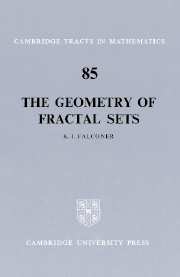Book contents
- Frontmatter
- Contents
- Preface
- Introduction
- Notation
- 1 Measure and dimension
- 2 Basic density properties
- 3 Structure of sets of integral dimension
- 4 Structure of sets of non-integral dimension
- 5 Comparable net measures
- 6 Projection properties
- 7 Besicovitch and Kakeya sets
- 8 Miscellaneous examples of fractal sets
- References
- Index
Introduction
Published online by Cambridge University Press: 25 January 2010
- Frontmatter
- Contents
- Preface
- Introduction
- Notation
- 1 Measure and dimension
- 2 Basic density properties
- 3 Structure of sets of integral dimension
- 4 Structure of sets of non-integral dimension
- 5 Comparable net measures
- 6 Projection properties
- 7 Besicovitch and Kakeya sets
- 8 Miscellaneous examples of fractal sets
- References
- Index
Summary
The geometric measure theory of sets of integral and fractional dimension has been developed by pure mathematicians from early in this century. Recently there has been a meteoric increase in the importance of fractal sets in the sciences. Mandelbrot (1975,1977,1982) pioneered their use to model a wide variety of scientific phenomena from the molecular to the astronomical, for example: the Brownian motion of particles, turbulence in fluids, the growth of plants, geographical coastlines and surfaces, the distribution of galaxies in the universe, and even fluctuations of price on the stock exchange. Sets of fractional dimension also occur in diverse branches of pure mathematics such as the theory of numbers and non-linear differential equations. Many further examples are described in the scientific, philosophical and pictorial essays of Mandelbrot. Thus what originated as a concept in pure mathematics has found many applications in the sciences. These in turn are a fruitful source of further problems for the mathematician. This tract is concerned primarily with the geometric theory of such sets rather than with applications.
The word ‘fractal’ was derived from the latin fractus, meaning broken, by Mandelbrot (1975), who gave a ‘tentative definition’ of a fractal as a set with its Hausdorff dimension strictly greater than its topological dimension, but he pointed out that the definition is unsatisfactory as it excludes certain highly irregular sets which clearly ought to be thought of in the spirit of fractals. Hitherto mathematicians had referred to such sets in a variety of ways – ‘sets of fractional dimension’, ‘sets of Hausdorff measure’, ‘sets with a fine structure’ or ‘irregular sets’.
- Type
- Chapter
- Information
- The Geometry of Fractal Sets , pp. ix - xiiPublisher: Cambridge University PressPrint publication year: 1985
- 1
- Cited by



